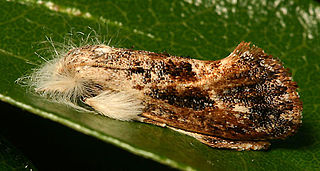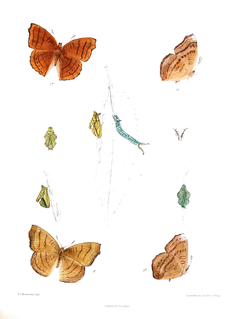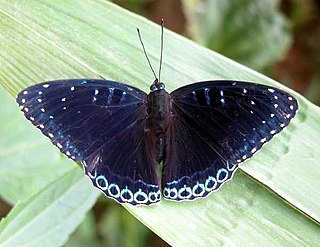
The Drake equation is a probabilistic argument used to estimate the number of active, communicative extraterrestrial civilizations in the Milky Way Galaxy.

In economics, the Gini coefficient, also known as the Gini index or Gini ratio, is a measure of statistical dispersion intended to represent the income inequality or the wealth inequality within a nation or a social group. The Gini coefficient was developed by the statistician and sociologist Corrado Gini.

Half-life is the time required for a quantity to reduce to half of its initial value. The term is commonly used in nuclear physics to describe how quickly unstable atoms undergo radioactive decay or how long stable atoms survive. The term is also used more generally to characterize any type of exponential decay. For example, the medical sciences refer to the biological half-life of drugs and other chemicals in the human body. The converse of half-life is doubling time.

A phylogenetic tree is a branching diagram or a tree showing the evolutionary relationships among various biological species or other entities based upon similarities and differences in their physical or genetic characteristics. All life on Earth is part of a single phylogenetic tree, indicating common ancestry.

Radioactive decay is the process by which an unstable atomic nucleus loses energy by radiation. A material containing unstable nuclei is considered radioactive. Three of the most common types of decay are alpha decay, beta decay, and gamma decay, all of which involve emitting one or more particles. The weak force is the mechanism that is responsible for beta decay, while the other two are governed by the electromagnetism and nuclear force. A fourth type of common decay is electron capture, in which an unstable nucleus captures an inner electron from one of the electron shells. The loss of that electron from the shell results in a cascade of electrons dropping down to that lower shell, resulting in emission of discrete X-rays from the transitions. A common example is iodine-125 commonly used in medical settings.
Holism is the idea that various systems should be viewed as wholes, not merely as a collection of parts. The term "holism" was coined by Jan Smuts in his 1926 book Holism and Evolution.

The saker falcon is a large species of falcon. This species breeds from central Europe eastwards across the Palearctic to Manchuria. It is mainly migratory except in the southernmost parts of its range, wintering in Ethiopia, the Arabian peninsula, northern Pakistan and western China. The saker falcon is the national bird of Hungary, the United Arab Emirates, and Mongolia.

The Eurotiomycetes are a class of ascomycetes within the subphylum Pezizomycotina.

Hydrogen (1H) has three naturally occurring isotopes, sometimes denoted 1
H
, 2
H
, and 3
H
. 1
H
and 2
H
are stable, while 3
H
has a half-life of 12.32(2) years. Heavier isotopes also exist, all of which are synthetic and have a half-life of less than one zeptosecond (10−21 s). Of these, 5
H
is the least stable, while 7
H
is the most.

Gracillarioidea is a large superfamily containing four families of insects in the order Lepidoptera. These generally small moths are miners in plant tissue as caterpillars. There are about 113 described genera distributed worldwide, the most commonly encountered of which are leaf miners in the family Gracillariidae.

Acrolophidae is a family of moths in the order Lepidoptera. The family comprises the burrowing webworm moths and tube moths. The family holds about 300 species in five genera, which occur in the wild only in the New World. It is closely related to the Tineidae family.

Scythrididae is a family of small moths in the superfamily Gelechioidea. The family is sometimes included in the Xyloryctidae as a subfamily Scythridinae, but the Xyloryctidae themselves have sometimes been included in the Oecophoridae as subfamily. Scythrididae adults are smallish to mid-sized moths, which when at rest appear teardrop-shaped.
A constable is a person holding a particular office, most commonly in law enforcement.
Bouliachelys is an extinct genus of sea turtle from Cretaceous Australia. Its parent taxon is the clade Dermochelyoidae.

Dichorragia nesimachus, the constable, is a species of nymphalid butterfly found in Asia. The genus was earlier considered to belong to the subfamily Cyrestinae and sometimes the Apaturinae, but is now considered as an sister of the genus Stibochiona in the subfamily Pseudergolinae. Several geographical forms with variations in colour are noted within the wide distribution range extending from India in the west to Japan in the east. In Vietnam, it is thought to show hill topping behaviour and is typically found in dense forest habitats. They may also be found mud puddling with other species.

Pseudergolis wedah, the tabby, is a species of Nymphalid butterfly found in Asia. In India, it is found along the Himalayas where it is somewhat uncommon and extends into Southeast Asia east to Vietnam. It bears a resemblance to the Castor butterfly Ariadne merione which was formerly placed in the genus Ergolis.
Chromerida is a phylum of unicellular alveolates, which includes photosynthetic species Chromera velia and Vitrella brassicaformis. General features of the phylum include spherical cells each with a thick cell wall, chloroplast present with chlorophyll a only, and an internal developing flagellum at some lifestages.

Pseudergolinae is a small subfamily of nymphalid brush-footed butterflies. It is considered to include only seven species in four genera distributed mainly in the Oriental region.
An annuity is a series of payments made at equal intervals. Examples of annuities are regular deposits to a savings account, monthly home mortgage payments, monthly insurance payments and pension payments. Annuities can be classified by the frequency of payment dates. The payments (deposits) may be made weekly, monthly, quarterly, yearly, or at any other regular interval of time. Annuities may be calculated by mathematical functions known as "annuity functions".

Severe acute respiratory syndrome coronavirus 2 (SARS‑CoV‑2) is a strain of coronavirus that causes COVID-19, the respiratory illness responsible for the ongoing COVID-19 pandemic. The virus previously had a provisional name, 2019 novel coronavirus (2019-nCoV), and has also been called human coronavirus 2019. First identified in the city of Wuhan, Hubei, China, the World Health Organization declared the outbreak a Public Health Emergency of International Concern on 30 January 2020, and a pandemic on 11 March 2020. SARS‑CoV‑2 is a positive-sense single-stranded RNA virus that is contagious in humans.















